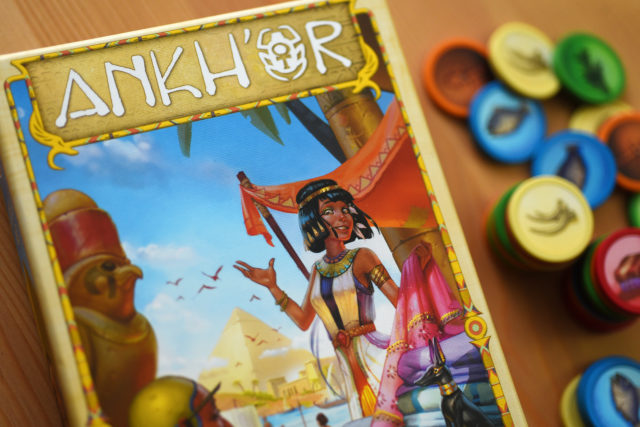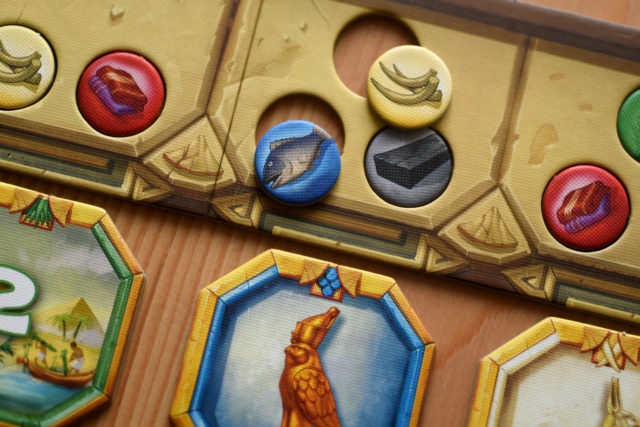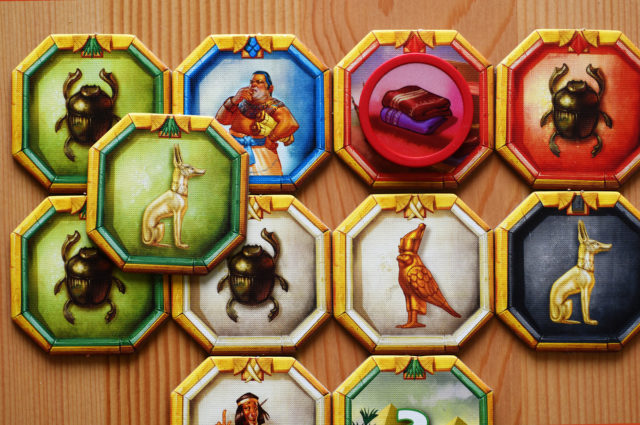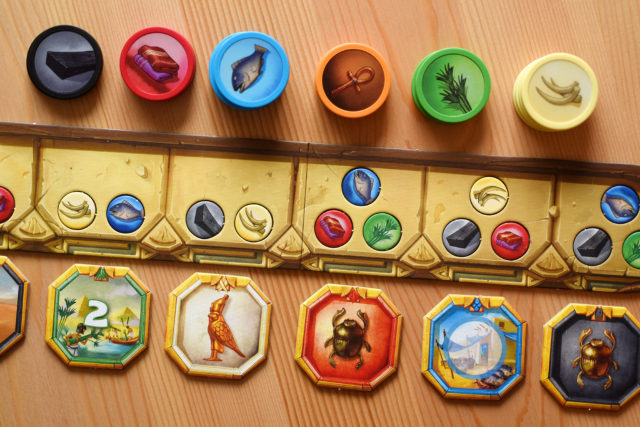One of the first great two-player games I learned was Jaipur by the super talented Sebastien Pauchan. In this game, you vied to be the best merchant over three rounds. A market of cards with different goods on them as well as deceptively important camels were available to both players on their turn. Each round, you either collect cards into your hand or sell them off. The bigger the grouping you sold, the bigger the bonus you took in return. This year’s reprint of Jaipur was the first game in Space Cowboys new 2-Player line. The followup is Ankh’or.

Technically, you can play Ankh’or with up to four players, but it’s particularly good for two and so falls into Space Cowboys’ new line.
Theme-wise, Ankh’or is pretty bare bones. You are an Egyptian merchant as far as I can tell, collecting resources and spending them on tiles from the market. The tiles you collect are connected to form a tableau that can earn you points. Once a player buys their 13th tile, the round is finished and scores are tallied. That’s the game in a nutshell. But if we crack that shell, there is a lot of interesting elements to Ankh’or.
The first thing Splendor fans will notice are the wonderful, tactile resource chips. They represent things like fish, textile, and bamboo, but they come in tiny, thick tokens reminiscent of the gems in Splendor, just pint-sized. On a turn, you can take resources or spend them in the market to buy tiles.

When you take resources, you collect three. You can have up to five of the resources, but you can also gain special Ankh tokens as well. You have a hand limit of two Ankhs on top of the resources. When you spend those resources at the market, you collect tiles. Here’s one of the neat elements in the game. There are a bunch of different market ‘stalls’. Each one is randomly seeded with two or three resource chips to indicate the cost of buying from there. Each games, the stalls will have a different collection of resources required to buy from there. It doesn’t exactly change the value of the various goods, because the frequency is the same, but the dynamic is different each time you play.
When you buy a tile, they don’t refill automatically. You have to spend an Ankh token to refresh the market. All of the remaining tiles slide down to the left and you choose a pile to refill the market with. The backs of the tiles each show you what colour the tile is on the other side, so you have at least some information about what you might be getting. Once you start filling from one pile, that’s the one you have to use until the market is full.
So what are you doing with these tiles you acquire from the market? They go into your personal tableau. Each tile you add must be either touching at least one other one orthogonally or sitting atop four tiles with at least one of them matching the colour of the new one added.

The tiles have two characteristics, their colour and their type. They have various different animals, like dogs, birds, and scarabs. There are also Warehouse tiles, 2-point tiles, Scribe tiles, and the uber crappy Desert tiles. There is a variety of of each in five different colours.
Where you place the tiles in your tableau is important for scoring points. Each grouping of two or more of the same colour or animal at the end of the game, earns you as many points as there are tokens in the group. If you manage to connect a group of five of the same type, you earn a bonus three points.
Scribes count for their colour type, but not for any animal grouping. The benefit for taking a Scribe is that you can immediately take an additional turn.

When you get a Warehouse, you immediately take a resource type on the matching colour and place it on the tile. That resource token doesn’t count against your hand limit. Even better, if you have an empty warehouse, you can put newly acquired resources of the same colour on there, you save putting them in your hand.
The 2-point tiles…well, they’re worth two points at the end of the game. I have nothing to add to that.
Finally, the Deserts count towards their colour, but nothing else. They don’t have any special benefits at all. Generally, you don’t want to take a Desert unless your options are seriously limited.
Once a player adds their 13th tile, game end is triggered. You finish out the current round and count up your scores.
Ankh’or is a nice little puzzle. It combines some of the market-timing element from Jaipur, with the simple resource collection and spending of Splendor. While I really enjoyed it, I can probably say that I’d prefer either of the other games to it. That being said, Ankh’or manages to squeeze itself into the narrow space between Jaipur and Splendor in terms of complexity. It is definitely worth trying out, and it may even replace one or both of those titles in your collection.
Comments
No comments yet! Be the first!